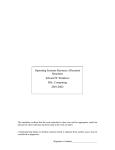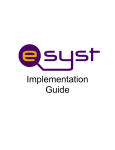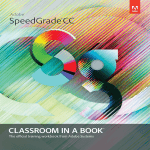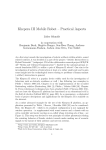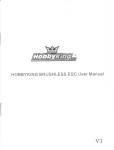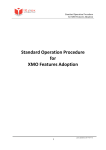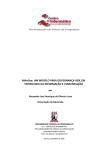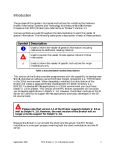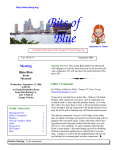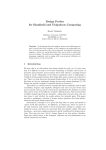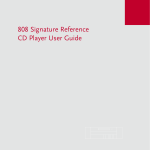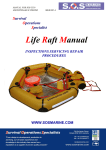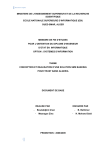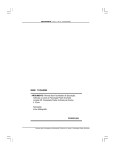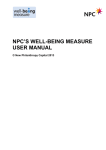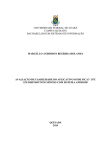Download Internet Banking Via Mobile Devices
Transcript
National
College0'
Ireland
TV colUye tor a
Internet Banking via Mobile Devices:
A Study of Usability and Consumer Attitudes in Ireland
Conor Murphy
Higher Diploma in Business in eBusiness
2008
Declaration
I hereby certify that this assessment is my own work and that the information contained in this
submission is information pertaining to research I conducted for this project. This work has not been
submitted for any other awards. All information other than my own contribution has been fully
referenced and is listed in the relevant bibliography section at the rear of the project.
Signed:
Date:
Student Number:
Abstract
New Mobile Devices are revolutionising the way we browse the Web. Large displays,
intuitive interfaces and fast data connections mean that the Mobile Web is finally fulfilling its
potential. Meanwhile Internet Banking has established itself as a vital channel for customers
to fulfil their financial needs and interact with their banks. As these two trends converge the
possibility of consumers accessing Internet Banking services via Mobile Devices seems likely
and Mobile Banking is predicted to grow considerably-over the coming years.
This study examines the usability of current Internet Banking services when accessed on
Mobile Devices and the attitudes of Irish consumers towards the possibility of Mobile
Banking. Surveys were carried out to assess what issues were of most importance to
consumers along with whether a demonstration of the service reduced these concerns.
While the sites assessed performed well in the usability study, it was found that the provision
of Mobile specific sites would be beneficial. In the attitudinal survey Security was found to be
the prime concern across all demographics when considering Mobile Banking followed by
Ease of Use, Speed and Cost. Simple education through demonstration of the service was
found to alleviate user concerns and increase the likelihood of users adopting the service.
It was found that there is a considerable potential market for Mobile Banking solutions in
Ireland and with the projected growth of the sector it would be important for Irish banks to
begin offering mobile specific services.
3
Table of Contents
D eclaration............:........................................... ........................................................................... ...... 2
A bstract............................................................................................................................ ...................... 3
Table of Contents.........;...;................................................... ............ ........................ :...... ......... ..... 4
List of Tables.........................!................................. .....................................................................•......5
Introduction........ ........................................................................................................................ .!..... 6
Literature R ev iew .................................................. :.........................................................................10
Internet B anking........................................................................................ ................ .................... 10
Mobile B anking........................................ ...................................................................................... 10
Mobile U sability........................................................................................... !.............................. 11
The Mobile Web............ ....... '.......... .......................................... :.................................... ...........13
Survey Design.........!..................................................................................................................... 14
Proposed Solution............................. ,.......................................... ................................................... 17
Usability S tu d y .............................................. ................................................................................. 17
Attitudinal Survey......................................................................................... .................................. 18
Education Survey........................................................................... .............................................. 20
Results and A nalysis.......................................................... .............................................................. 22
Usability Testing.................................................................................................... ...................... 22
Mobile Usability of Banks Homepages...!..................................... ....................................... 22
Allied Irish Banks - Internet Banking...........................................................................:....... 26
Bank o f Ireland - 365 Online.............. .............................................. !..... ................ .............28
Ulster Bank - Anytime Banking.............................................................................................. 30
Attitudes S u rv ey .... ...... ................................................................................................ .............. 32
Demographics.......................................................................................................................... 32
A g e................................................ :....... ................................................................................... 35
Income L ev e l............................................................ .................... ................................. ........ 36
Technological Ownership..................•..................................................................................... 37 .
Usage of Internet and Mobile W eb.......................................................................................... 38
Usage of Internet Banking........................................................................................................39
Usage o f Internet Banking via Mobile Devices...................................................................... 39
Factors affecting Internet Banking via Mobile Devices........................................................ 40
Education Survey.............................. ................................................ ...........................................42
' Demographics.................................................. .................................................. ..................... 42'
. Technological Ownership and Usage.................... '................................................................42
Initial F actors....................................... ...................................................... .............................. 43
Post Demonstration Factors.................................................................................................... 43
Adoption R ate........................................................................................................................... 44
Key Activities ........................................................................................................................... 44
Future W ork........................................................................................ i..............................................45
Conclusions..........................................!......................................... .................................................. 47
Bibliography......................... ...................................................... :.....................................................48
Appendix A - Attitudinal Survey................... :................................................................................ 52
Appendix B - Educational Survey................................................................................................. 56
4
List of Tables
Table
Table
Table
Table
1. Results of MobileOK Checker.................... ...................................... ............................ 25
2. Demographic Features of Respondents.............................................................................34
3. Salary of Respondents............ ......................... .............................. ................................... 37
4. Average Ratings of Factors of Importance.........................................................................41
Figure 1.
Figure 2.
Figure 3.
Figure 4.
Figure 5.
Screenshot of AIB Internet Banking on Opera M in i....................................................27
Screenshot of BOI 365 Online on Opera M ini..............................................................29
Screenshot of Ulster Bank Anytime Banking on Opera M in i..................................... 31
Trend of Importance of Security across Age G roups................................................... 36
Trend of Importance of Cost across Age Groups......................;................................... 36
5
Introduction
In recent years several mobile devices have been introduced which have claimed to bring the
“real Internet” browsing experience to the pockets of consumers. While before consumers had
to make do with small and low resolution displays, awkward data entry and slow rates of data
transfer, they now have devices such as Apple's iPhone, Nokia's N95 and various Blackberries
and Smart phones. These next generation mobile devices offer generous, vivid displays,
intuitive interfaces and lightening quick 3G access. While there still are many differences
between browsing the net with Internet Explorer on a desktop compared to the iPhone's Safari
and Firefox on a laptop compared to Opera Mini on a Smart phone, the gap is narrowing and
the full web experience is definitely coming to Mobile Devices.
As this change in the way we browse the web on the move has been taking place, Internet
Banking has established itself as an important channel in the financial services industry for
both personal, and business customers. The largest Irish bank Allied Irish Bank (AIB) has over
490,000 active users and claims 30 million logins to the service in 2006 with growth of 21%
per year. Its nearest competitor and Ireland’s second largest financial institution Bank of
Ireland (BOI) has over 550,000 users registered [Irish Times, 2006]. These figures represent
approximately 20% to 30% of the banks customers and illustrate the popularity of Internet
Banking. Increasingly retail banks are pushing this new channel with online only products
such as high-interest savings accounts and credit cards that can only be applied for online.
Worldwide, Internet Banking has become a staple of banking strategy from established
countries such as the United States [Kolodinsky, 2001] to developing nations such as Nigeria
[Chiemeke, 2006]. The increased popularity o f and reliance upon broadband services across
the nation coupled with the shrivelling spare time of a booming economy's population meant
that Internet Banking was not just a novelty but an essential service. Banks have utilised the
popularity of the service and its unparalleled convenience and speed to reach out to
consumers in a new and innovative manner.
While the growth of Internet Banking over the past 10 years has been successful, experiments
in Mobile Banking have been popular but not succeeded to the same extent. With the massive
amount of Mobile Phone users across the globe and its increasing status as an essential item,
it makes sense that both the banks and their customers should pursue Mobile Banking. There
are over 3.3 billion mobile phone users worldwide and Ireland is one of 59 countries that can
6
claim over 100% penetration rate [Informa, 2006]. Unfortunately, the first forays into mobile
banking.via WAP suffered from slow and unreliable connections and users disliked the small
screen size and awkward nature of data input. Further attempts using Short Message Service
(SMS) were similarly unsuccessful. SMS protocol does not guarantee a set timeframe or even
•delivery of the messages and this adds an air of unreliability to the service [Rotimi et al,
2007]. There are also concerns over the security and possible fraud with the service [Boyer,
2008]. These factors coupled with a perception that security was not as robust as its desktop
counterpart caused Mobile Banking to stutter while Internet Banking flourished. However
with faster connections, more user-friendly devices and applications developed using xHTML
and other standards used for desktop browsers, the potential of Mobile Banking solutions is
being talked up again. In recent years banks have been attempting to get a head start on what
many believe will become a huge growth market. A report by telecom analyst firm Juniper
[2007] predicts “the number of consumers accessing banking services and products via their
mobile phones will reach 816 million by 2011”. In America, several leading banks have
mobile solutions on offer already including Bank of America, Wachovia and Wells Fargo.
Bank of America alone claims over 840,000 active Mobile Banking users with 224,000
enrolling in the first quarter of 2008 [Bank of America, 2008] indicating that the service is
growing strongly. In the UK, Barclays have launched a Mobile Banking solution [Barclays,
2007] hoping to convert some of its 1.9 million Internet Banking customers to Mobile
Banking. The Barclays site and those similar to it typically use the “.mobi” domain. This
means that they are separate sites devoted to mobile users and tailored to suit their needs.
Either the users goes specifically to the mobile site or the browser that is being used is
detected upon the user first entering the site and they are redirected to the mobile site if a
Mobile Web browser is detected. This ensures that the site the user is viewing is optimised to
work best on mobile devices and offer the services that are deemed most important for mobile
users. None of the Irish retail banks have mobile-specific websites in operation at the time of
this study but the .mobi domain is becoming more popular with Deutsche Bank of Germany,
Standard Bank of South Africa and UniCredit Group of Italy all joining Barclays in
registering such domains. The interest in such sites is also not limited to financial institutions
with international giants such as BMW, Hilton Hotels and Time Magazine also registering
Mobile domains.
This predicted growth in mobile services is in part down to the new generation of Mobile
Browsers that have become commonplace on most new Mobile Phones. Opera offers two
7
versions of its Mobile.Browser. Opera Mini is a lightweight browser that is claimed to be able
to run on any handset While Opera has not released any figures on the amount of downloads,
Opera Mini does claim to have over 44 million cumulative users [Opera, 2008]. There is also
the more heavyweight Opera Mobile which takes up more space and memory on the device
but which has a greater range of functions such as downloads and Flash Lite support offering
a fuller browsing experience. Both browsers allow the user to integrate the bookmarks of their
desktop and mobile browsers ensuring a cohesive browsing experience across platforms and
further emphasising the reduced gap between the Mobile Web and the full Web. Apple's
iPhone is proving as much a revolution in the Mobile Phone world as the iPod was in the MP3
world. The innovative interface has changed our perception of how we interact with our
Mobile Devices and the initial lack of full 3G connectivity did not dwindle consumers’
appetite to browse the Web on the Safari browser. The recent announcement of a 3G version
[Apple, 2008] will only lead to more people discovering the power of the Mobile Web via the
onboard Safari browser. Apple’s Steve Jobs claims to have shipped over 4 million iPhones
already; each with Safari preinstalled making it is one of the forerunners in the new Mobile
Browser market. The old mainstays of desktop web browsing.Firefox and Microsoft also have
their own mobile versions with Firefox Mobile and Internet Explorer Mobile and most Mobile
Devices come with some breed of browser preinstalled.
As voice calls, become a commodity, data transfer is increasing becoming the solution for
mobile operators searching for a new revenue stream. The promotion of. free access to the
social networking site Bebo by 0 2 and other such initiatives is a conscious effort by
companies to encourage the use of mobile sites and thus increase revenue from data
transmissions. Internet Banking could conceivably become such an essential site for mobile
access with the correct promotion. In response to growing consumer demand and to promote
usage, more operators are offering bundles of data and unlimited data packages. These are
becoming commonplace in America with the main, mobile operators Verizon, AT&T and
Sprint offering such plans. This is driving down the cost of Mobile Web access and making it
a more attractive proposition to consumers. Meanwhile there is a continuous* stream of
powerful new devices coming to the market with large, user-friendly screens and high-speed
connectivity. Wi-Fi connectivity is also becoming a standard feature on mobile devices and
even on MP3 players such as the iPod Touch, further allowing users to explore surfing the
Mobile Web on the move. •
As all of these factors converge, it is becoming obvious that consumers have all the pieces in
place in order to use Internet Banking on the move. This study examines whether users are
likely to adopt Mobile Browser Banking or using -Mobile Web Browsers to cater for their
banking needs. There will be a usability survey to determine whether the main Irish banks are
prepared for users to access their sites in this manner. The main area o f research will examine
consumers’ willingness to try .Mobile Browser Banking, what their main concerns are and
whether being provided with information to alleviate these concerns can change their
perception of the service.
9
Literature Review
Internet Banking
Internet Banking has been in existence in Ireland in some form for 10 years now and as a
channel o f distribution its impact cannot be underestimated. Bradley and-Stewart [1999] have
shown that it should be an integral part o f any banks strategy and research shows that banks in
the UK and Ireland have been keen to adopt this new technology [Daniel, 1999]. The rise in
computer ownership and broadband availability has lead to Irish consumers embracing
Internet Banking while not completely abandoning the traditional'branch [Irish Times, 2006]!
Between the years o f 2005 and 2007. alone the number o f households using Internet Banking
has jumped from 387,300 to 651,900 according to statistics from the Central Statistics Office
(CSO) [2007]. This shows that Irish consumers are becoming more likely-to carry out their
banking needs online. From an international perspective there are many academics examining
the implementation of Internet Banking in various regions such as the United States
[Kolodinsky, 2001] and Malaysia [Sivanand et al, 2004], There is also considerable research
into the types of people who are utilising these services such as Amin’s study o f adoption
among young intellectuals [2007], This study found that young, educated individuals would
adopt the service as long as there is a perceived usefulness, ease of use and credibility
associated with the service. Kim et al [2005] found that users -who have previous experience
with electronic banking solutions are more likely to adopt Internet Banking and that education
can play a part too. Similar studies into consumer adoption in Australia by Sathye [1999]
showed that “security concerns and lack of awareness about Internet banking and its benefits
stand out as being the obstacles to the adoption of Internet banking”.
Mobile Banking
There has been considerable research into the area o f Mobile Banking including analysis o f
the markets in Japan [Scomavacca, 2004], China [Laforet and Li, 2005] and Finland
[Suoranta, 2003]. It is generally found that the likelihood o f users adopting Mobile Banking
solutions depends upon the perceived security o f the solution with Wang investigating the
need for “perceived credibility” [Wang, 2003]. Pousttchi and Schurig’s assessment o f mobile
banking solutions [2004] identified requirements in order for security to be adequate. These
were that data was encrypted, that access to data must be authorized and that this
authorization process must be simple. Mobile Banking solutions should also have a perceived
10
ease of use. Amin et al [2007] found that banks “should develop the belief o f usefulness and
ease of use by providing sufficient information on the benefits o f mobile banking. In order to
achieve this, banks should provide user manual that contains details oh mobile banking,
including usefulness and ease of use”. This will be explored within this study with th e '
examination o f the effect of simple education regarding the service to consumer attitudes. It
has also been found that age plays a part in the likelihood of consumers to access the web via
their mobile device and consequently their likelihood to access mobile banking. Senecal
[2008] finds that mobile Internet usage tends to. drop off sharply with age. An average of 32%
of those under 39 years old were likely to use a Mobile Device to access the web with that
figure dropping to an average o f 21% for those over 40 years old and just 18% for those 60
years old and higher.
Mobile Usability
In order to understand the requirements for a well-built Mobile Web site, research was carried
out into various aspects of Mobile Web design [Nokia, 2004] [Zhang and Adipat, 2005]. The
W 3Cs Mobile Web Best Practices guidelines [Rabin and McCathieNevile, 2006] were used
as a starting point for developing the usability study criteria. These criteria are similar to those
laid out by W3C for regular websites and are created to ensure uniformity and compatibility is
in place across the Internet. These guidelines were complimented by literature from usability
and design analysts Webcredible. [2007] and Buchanan’s [2001] study of “Improving Mobile
Internet Usability”. It was found that the major factors to be considered when designing for
the mobile web are meeting users needs quickly, ease of navigation, ease of input and mobilefriendly layouts.
It is essential that users needs be addressed quickly on mobile websites. At present the mobile
web is not most users preferred way o f browsing the Internet. It is something that is used to
kill time or with a sense o f urgency in order to gather information that cannot wait. While new
devices are helping to change this attitude and encourage users to browse the web in a more
leisurely fashion it is still imperative that essential information is readily to hand. The key
features o f the site can be determined by assessing what mobile users are most likely to want
when accessing the site. In keeping with meeting users’ needs, only information that is
important to the user should be shown. Users will not be accessing a mobile website of a bus
operator in order to arrange advertising on bus shelters. They will more than likely be looking
11
for a timetable or information on a particular bus route. Non-essential information should not
be included or should at least be given less priority than information deemed essential. O f
course it is important that users be consulted in order, to determine what' constitutes this
essential information by encouraging a user-centric design process.
As display sizes are small and users generally do not want to scroll down through pages of
unnecessary options before reaching their desired content, navigation should be as easy as
possible. Most mobile browsers lack the toolbars of their desktop counterparts and it is
possible that moving back and forth through the website may be difficult. Basic browsing
controls should be on each page so as to ensure smooth navigation throughout the site. These
controls .should not however distract attention away from the essential information being
displayed.
In order to minimise user frustration and errors, users should be allowed to choose from
possible options instead.of laboriously typing in their selections on a mobile keypad. Typing
can be cumbersome on mobile devices and errors are more likely to occur. It is often difficult
to correct mistakes on some devices leading to users having to start all over again. O f course
some search option may be available for more advanced users.
The layout of a mobile website may be dramatically different from that of a full desktop site
as screen sizes are smaller and the type of browser may not be as powerful. Many mobile
browsers also realign layouts to display the content in a more efficient manner. There are
countless different types of Mobile browsing applications used across many different types of
phones with varying specifications. With this in mind the site should be designed for the
lowest common denominator device and should attempt to render on all platforms. By
ensuring that these standards are met across the major Mobile browsing platforms such as
Safari, Opera, Internet Explorer Pocket and Openwave, a user friendly and effective site can
be designed.
Other considerations for mobile users apart from usability include security, speed and cost.
While Opera and Safari offer robust security measures such as 128Kb encryption and Secure
Socket Layer (SSL) support, it is still important to build users trust in the applications.
[MORE] Cost is considerably important to potential users and up until recently prohibitive
charges for mobile browsing have put many users off. A report from market research group
12
Media Screen found that while 60 percent o f broadband users own Internet-enabled devices,
only 5 percent regularly use them for web access [Netpop, 2007]. Roto et al, [2007] also
found that consumers are wary of the cost incurred while browsing on mobiles due to three
factors; hard to know how costs cumulate, hard to follow cost accumulation and hard to
control costs. They proposed better transparency of data costs from mobile operators and
acknowledge the future impact of Wi-Fi connectivity, being added to mobile devices.
The Mobile Web
The various solutions for browsing the Mobile Web were also examined as part of the
literature review. As the demonstrations were carried out on Opera Mini, this was looked at in
depth. The Opera browser has been in existence since the early, days o f the Web in 1995 and a
mobile version has been around since 1998. It is claimed that Opera has “more than 44
million cumulative Opera Mini users worldwide” [Opera, 2008] and this would make it one of
the most used Mobile browsers on the market. This figure however may include users who
have downloaded more than one version of the software onto various devices and may not be
representative of the true amount of users. One of the many benefits of Opera Mini is that is
that it processes pages in such a way as to reduce the amount of data required and thus ensure
faster loading times and lower data costs. For a more robust browsing experience, Opera also
offer Opera Mobile, a more heavyweight sibling designed for smart phones and personal
digital assistants (PDA). The browser preinstalled on the Apple iPhone and iPod Touch is
Safari, which has many of the features of Opera. With over 4 million iPhones sold and an
attractive interface this is one of the forerunners in promoting the Mobile Web. In a further
sign of its influence on mobile browsing habits Citibank has embraced the device to push its
Giti Mobile service. Drew Sievers of Citibank’s technology partner mFoundry says the iPhone
is “the sort of phone that can help to push the mobile banking service into the mainstream”
[ABA Journal, 2007]. Devices that run on the Windows Mobile platform generally come
equipped with Internet Explorer Mobile and Firefox, one of the world's most popular desktop
browsers, has a mobile version called MiniMo. While not quite as ubiquitous as their full
sized counterparts both products are actively developing new versions [CNet, 2007].
13
Survey Design
In order to ensure that the surveys taken as part of this study were adequately, designed and
garnered credible results it was important to research survey design methods and techniques
for information* gathering. Oppenheim’s “Questionnaire Design, Interviewing and Attitude
Measurement” was invaluable in the design process of the survey; Further guides by Burgess,
2001] and Sudman [1983] further informed the research into survey design techniques.
14
Problem Description
.With over 1 million subscribers in Ireland alone, Internet Banking is now an essential channel
for Irish retail banks. Early analysts may have expected it to completely replace branch
banking [Nehmzow, 1997] but this has not been the case. It has however become an integral
part of every banks' multi-channel delivery strategies and offers an added layer o f
convenience to customers and a platform on which banks can innovate with new products and
methods o f customer service. As mobile phones begin to offer a new platform for banks to
take advantage o f it is important that the views o f prospective users are gathered and the
likely pitfalls that may present themselves are identified. In the absence o f any Irish banks
providing mobile solutions at present it is important to assess this new channel and its
potential.
The problem facing this study is how Ireland's major retail banks are prepared for the
impending growth in demand for mobile solutions, how consumers feel about using such
solutions and whether providing potential users with information can alleviate their concerns.
As Mobile Banking has the ability to become such a massive growth area over the coming
years, it is important to determine now how prepared these banks are for mobile solutions.
The figures for devices sold and applications downloaded show that consumer are beginning
to browse the Mobile Web regularly. Should these early adopters be confronted by websites
with poor usability it may be off-putting. This may in turn discourage users from carrying out
their banking needs in such a manner. Therefore it is important to carry out a usability study
in order determine the current usability of Internet Banking sites on Mobile Devices. By
doing so key areas o f concern can be identified early and the correct measures be taken.
Customers’ attitudes towards such a service also need to be established. Whether users are
embracing the services and whether they are keen to embrace the service in the future are two
pressing concerns. .While the introduction o f new devices and the roll out o f Mobile Banking
services in areas territories such as the United States indicate that this will be a growth area in
the future, it is important to determine for certain that users would be willing to adopt such a
service in Ireland. More importantly it is essential to establish where any potential user
concerns lie and what barriers exist that would stunt the potential growth o f this trend. By
establishing these issues early it enables them to be addressed in the planning stages o f
Mobile Banking solutions and ensures a user focussed service is provided that addresses the
15
main concerns. As ease of use and trust have been linked to consumer adoption of Internet
Banking, a user-centric design process is essential for success.
Finally it is also imperative in the introduction of Mobile Banking solutions that potential
users are adequately educated in order to get the most out of the service. This process of
education not only serves to benefit financial institutions by ensuring customers are more
likely to use the service and reducing customer service requirements, but also benefits mobile
operators as it ensures people adopt data transfer and web browsing on Mobile Devices. This
is a lucrative revenue stream and would be assisted by applications such as banking coming
into more mainstream use. Users would also benefit from the convenience offered by Mobile
Banking and the reassurance that simple education would provide.
16
Proposed Solution
Usability Study
In order to assess the current state of Internet Banking on Mobile Devices, a usability study
was undertaken to determine how. effective Irish Internet Banking sites are when viewed on
Mobile Browsers. By doing so it can be established whether the main banks are already able
to accommodate users on Mobile Devices or whether these sites need to undergo a redesign in
order to meet mobile web requirements.
The usability study was carried out on three of Ireland’s largest banks and their Internet
Banking facilities. They were Allied Irish Bank's (AIB) Internet Banking, Bank of Ireland's
(BOI) 365 Online and Ulster Bank's Anytime Internet Banking. These financial institutions
were chosen as they are the among the largest and most established retail banks in Ireland
Firstly, the home page o f each bank's website was checked using W3C's MobileOK Basic
Checker [MobileOK, 2008] to confirm if they meet the standards set down in the
organisation's Mobile Web Best Practices document [Rabin and McCathieNevile, 2006]. As
the bank's homepage may be a starting point for many Internet Banking users, it is important
that this is mobile compliant as well as the Internet Banking site if there is no mobile specific
version. Should there not be a specific mobile homepage or the homepage not render properly
on a mobile device, it may put users off before they have even sampled the service. The
results, from the MobileOK Checker will show how prepared the banks current Internet
Banking solutions are for mobile users. It performs 25 individual tests on the structure and
performance of the site and reports back on what tests were failed. By analysing these failed
tests in conjunction with the W 3C’s proposed guidelines, the'key areas requiring attention can
be identified.
Each site was then accessed using one of the most popular Mobile Web Browsers, Opera
Mini. Following a literature review it was found that in order to perform well on Mobile
Devices sites should follow certain guidelines. These include meeting users' needs quickly,
ease o f navigation, ease of input, important information being readily available, mobilefriendly layouts and basic browsing controls. These factors were combined to create four
categories on which the sites were assessed. These were: availability of essential information,
ease of navigation, nature of data input and layout and rendering. Alongside being graded on
these factors, the amount of data received was also noted. In the absence of unlimited data
17
packages from mobile operators, it is important to gauge the cost of using Internet Banking on
Mobile Browsers as cost can play a large part in users deciding to adopt a service or not [Roto
et al, 2006]. Some common tasks were carried out in order to obtain a balanced view of each
service. These tasks included checking account balances, viewing recent transactions on
accounts and the process involved in applying fro services such as loans. While this usability
study used Opera Mini running on a Nokia N95, it would be possible to carry it out on a
number of mobile browsers. Initially, Internet Banking on an iPhone Safari emulator [iPhone,
2008] was intended for assessment also in order to produce a more rounded usability study.
However it was found that the Internet Banking sites being assessed block emulators from
viewing the site. This may be due to possible security problems posed by such applications
and so the usability study on Safari was not used.
.
Attitudinal Survey
In order to determine the attitude of consumers towards Internet Banking using Mobile
Devices a survey was carried out. The purpose of this survey was to investigate the type of
consumer that is most likely to bank via their mobile phone browser, the likelihood of future
take up and what factors have to most influence on people’s perception of Internet Banking
via Mobile Devices.
The survey gathered information on the general demographics of respondents, their attitudes
towards technology, the frequency of their interactions with both Internet Banking and Mobile
Devices and where their main concerns lay. The demographics established were, sex, annual
income, age, level of education and area of employment. With this information it could be
determined whether specific demographic values played a part in consumer attitudes. It would
also help indicate the likely target audiences for future Mobile Browser Banking services.
Secondly, it was established what relevant devices and services the consumer owned or
engaged with, and the frequency with which they were used. This information revealed the
extent that the respondent was already exposed to or reliant upon certain technologies and
services. Ownership of mobile phones and computers was established along with what
services they utilised on these devices. This included the usage of the Internet, Internet
Banking, and the Mobile Web. Where the respondent had previously used these services, their
satisfaction and frequency of use was established. Where the respondent had not had previous
experience with the service, their likelihood o f future use was determined. The final section of
18
the survey dealt with various factors of concern and their level of importance to the
respondent should they access Internet Banking on a Mobile Phone Browser. The factors were
ease of use, security, cost of access, the presence of an attractive user interface, the range of
services' on offer and the speed at which information could be accessed. Respondents had to
rate these factors on a 5-scale range from Very Important to Very Unimportant with Average
as the median scale. These responses were weighted with Very Important being given a
weight of 5 and Very Unimportant being given a weight o f 1. The resulting average rating was
used to determine the importance of the factor being examined. Where factors had equal
ratings, whichever more respondents deemed Very Important was ranked higher.
The survey was hosted on the online survey tool Survey Monkey [2008]. This is a powerful
online facility with which surveys can be created and hosted and the results analysed. In order
to ensure a high response rate the survey was kept relatively simple and uncomplicated.
Respondents were guaranteed of their anonymity and that no financial details would be
required. This was to dispel any fears that respondents may have had regarding possible fraud
or “phishing” [Downs et al, 2006] attacks. Phishing is a method o f obtaining users private
information by fooling them into thinking that they are viewing a reputable site when they are
not. As this form of fraud is increasingly common it was important to reassure respondents
that no information relating to their Internet Banking details would be required. The link to
this survey was sent out via email to 95 recipients who in turn were asked to pass it on again.
This method of collection may be referred to as “snowball sampling”. This is a method in
which existing respondents are called upon to recruit new respondents in a continuous
manner. While this method is good for increasing the sample size it does have certain biases.
Future respondents recruited by the existing respondents are more likely to come from similar
social backgrounds. The survey was open for access via this link for 6 days and received 117
responses. O f these 117 responses, only 115 were fully completed and therefore only 115 will
be analysed for the purposes of this study. Due to the fact that the survey was passed on from
the original recipients to an unknown amount of others it is not possible to quantify the total
number of people that received the link and therefore the total response rate. Also as the
survey was carried out online, there is a considerable bias towards those who are
technologically proficient as they must have some sort of online presence and technological
aptitude in order to receive the link and access the survey hosting site. While this makes the
survey unreflective of the opinion of the general public as a whole, it does enable it to be used
as a snapshot o f experienced Internet users’ attitude towards Internet Banking via Mobile
19
Devices. It is likely that the target market o f Mobile Browser banking, should it be
implemented, would be made up of consumers who are already adept at Internet Banking.
Education Survey
Due to the previous lack of adequate devices on the market, high cost o f data transfer and lack
of user knowledge Mobile Browser Banking is still in its infancy. As a result of this it was
considered important to determine the effects o f simple education on consumers. This was to
ascertain if consumers might consider using such a service when concerns over factors such
as security and cost were addressed. Should users concerns be relieved by such basic
information then it may be in stakeholders interest to provide this information to users in
order to encourage take up of the service. For example, it may benefit banks to promote the
security o f certain Mobile Browsers on their sites as Barclays has with its mobile site
[Barclay, 2008]. On it Barclays encourage the use of Opera Mini and offer links to download
locations and security information for potential users. Mobile operators may also wish to
promote the usability of certain banks’ sites in order to encourage the use of mobile services
and thus increase revenue from data transfer fees.
The survey was carried out by selecting respondents at random with no bias towards age
groups, area of employment, technological competency or other factors. Overall 15 candidates
were selected for the educational survey but only 13 surveys were completed in their entirety
giving a total response rate of 86.6%. These respondents completed a survey identical to that
used for the attitudinal survey mention previously. This was in order to gather demographic
information and determine their initial views on the service. Following completion of this
primary survey, the respondents were then given a brief demonstration of Internet Banking on
a Mobile Devices and provided with some information relevant to the service. The
demonstration was carried out on a Nokia N95 using the Opera Mini browser to access AIB’s
Internet Banking service. The process of starting up the browser, accessing the site and
logging in by providing a registration code and security information was displayed. The
services on offer, how to view balances and recent transactions were also shown to the
respondent. They were also provided with information concerning the security features of
Opera Mini and similar browsers, the process of inputting data and navigating with the
browser and the typical data costs and speeds of the main Irish Mobile operators. This
information was considered to address issues regarding security, ease of use, cost and speed
20
respectively.. Where possible, any questions that the respondents had regarding the service
were also addressed as they arose. Following the demonstration, a follow-up survey was
carried out to assess whether the respondents attitude towards security, ease of use, speed,
user interface, cost and range of services had changed. They were also asked for any other
concerns they may have, whether they would consider using the service and the activities they
thought they would most commonly use on the service. This final question of what services
would be most used could be useful if the service was introduced in order to determine what
services should be given priority and made most user friendly.
21
Results and Analysis
Usability Testing
Mobile Usability of Banks Homepages
The W3C Mobile Web Initiative [W3C, 2008] has a free online tool to check the compliance .
of web pages with their Mobile Best Practices 1.0 Guidelines [Rabin and McCathieNevile,
2006]. By entering the addresses of AIB, BOI and Ulster Bank's homepages and checking the
results, it can be determined how prepared for embracing the Mobile Web these Irish banks
are at present.
Allied Irish Bank's homepage [AIB, 2008] failed 5 of the 25 tests and presented 2 warnings.
The failed tests were for the use of auto refresh and redirection on the page, not having any
caching information, not having any character encoding specified, no page title defined and
not using valid mark-up. The use of auto refresh or redirection on the page is negative as it
may add undue costs onto the browsing session. Redirection may also add undue cost or
delays to viewing the page and is similarly discouraged. Caching is the process o f saving
regularly accessed information in order to reduce the data required and time taken when
revisiting the site at a later date. By not employing caching the browsing experience can be
inefficient and slower than is necessary. By employing caching the cost of the browsing
session may be reduced, as less information must be requested. By not specifying, the
character encoding being employed by the site, it is impossible for the browser to establish if
it supports the encoding without requesting information. By explicitly defining the encoding
type it ensures the browser does not have the wasted time and expense of requesting the
information if it is not supported. A short descriptive title should be provided to allow users to
easily identify the page when browsing history or bookmarks and make navigating to it easier.
The page ,should also “validate to published formal grammars”. This means that the mark-up
of the page should conform to the standards for websites laid out by the W3C organisation in
their Web Content Accessibility Guidelines [Chisholm, 1999] and other proposed guidelines.
The Bank of Ireland homepage [BOI, 2008] fared slightly worse than AIB with 8 failed tests .
and 117 warnings presented on the page. The failed tests on AIB’s site for not caching
information, not defining character encoding and not using valid mark-up were repeated here.
Added to these were failings for image resizing and not specifying image size, using pixel
22
measures or absolute values, not having non-text alternatives, exceeding the page size limit
and the use o f pop-ups. By defining the size of images in the mark-up, it enables the browser
to determine the size of the images in advance and layout the page appropriately. Also
resizing o f image should be carried out at the server if required. This reduces the amount of
data that has to be transferred and thus reduces the cost and time taken to display the page. By
not defining pixel and absolute measures it allows the browser to adjust the layout of the page
to best suit the display being used. The use of images while browsing on mobile devices adds
considerable time and cost to the browsing experience. Most browsers enable users to disable
automatic loading of images. This enables users to determine the usefulness of a particular
image before it is downloaded and saves time and expense. By offering a text alternative such
as a brief description the page can be easily viewed in text-only form and gives the user the
option to identify images deemed necessary. The Best Practices have defined specific page
size limits as some devices have a maximum size that content can be and the memory on
many devices is quite limited. The limit for the mark-up documentation is 10 Kilobytes (Kb)
and for the entire page including images and external resources is 20Kb. The BOI page has a
mark-up that is 13Kb in size and an entire page size of 38Kb. By exceeding the defined limits,
the page may take too long to load up or may not even load at all on some devices. Finally the
use of pop-ups on the BOI page caused a failed test. The reasons for pop-ups being
discouraged are similar to those for redirection and auto-refresh. They can add undue cost
onto the browsing session and are unsupported by many applications. While the presence of
117 warning on the page may seem excessive, the majority were for default values not being
defined and this figure did not represent 117 different types of warning.
Finally, Ulster Bank [Ulster Bank, 2008] fared the worst of the 3 sites tested with 10 failed
tests and 63 warnings. They failed tests on specifying character encoding and the use of valid
mark-up as well as both AIB and BOI. They also failed tests on image resizing, measures, the
use of pop-ups and exceeding the page size limit alongside BOI. Their mark-up exceeded the
recommended 10Kb for documentation with 15Kb and their 54Kb size for the entire page
dwarfed the recommended 20Kb outlined in the guidelines. As well as these failures they
were also marked down on the use of external resources, the use of image maps and the use of
tables for layout. For each external resource used, a separate request must be sent out over the
network and this adds considerable time to the load time of the page. The Ulster Bank page
•uses over 20 embedded external resources; this may lead to excessive time to the process of
loading the page. Often some mobile devices do not support the use of image maps and so
23
they should not be used unless it is known that the devices can support them. Ulster Bank's
- final failure was the use of tables to define the layout o f the page. Tables do not lend
themselves well to small screen sizes as they may require users to have to scroll horizontally
to view content and makes the browsing experience cumbersome.
While none of the sites tested completely passed the W3C’s MobileOK Checker, it would not
be difficult for some to come in line with the requirements. All three sites failed for not
utilising caching, not defining character, support and not using valid mark-up. Not using
caching may be used explicitly to prevent instances o f fraud or to protect users privacy.
Amending the documentation of the site can easily rectify the other two common failures.
AIB performed the best in the checker and would appear to have errors that while needing
attention would not have an overly detrimental effect on the users browsing experience. BOI
also performed well but issues such as large page sizes and layout issues would mean their
site would require more attention. The Ulster Bank site would need a considerable overhaul in
order to meet the requirements. The reliance on image maps and external resources would
need to be rectified and this in turn would probably reduce the considerable 54Kb page size.
24
Table 1. Results of MobileOK Checker
l i l l l i S
* FAIL *
PASS
PASS
* FAIL \
* FAIL *
PASS
* FAIL *
* FAIL *
* FAIL *
PASS
PASS
* FAIL *
* FAIL *
* FAIL *
* FAIL *
PASS
PASS
£Exteraal?Resource^
PASS
PASS
* FAIL *
iG npicsT foflSp^^^
PASS
PASS
PASS
PASS
PASS
* FAIL *
PASS
* FAIL *
* FAIL *
PASS
PASS
PASS
* FAIL *
* FAIL *
PASS
PASS
PASS
PASS
PASS
PASS
, PASS
* FAIL*
PASS
PASS
PASS
PASS
PASS
* FAIL *
* FAIL *
* FAIL *
PASS
PASS
« p iu p p i
PASS
* FAIL *
* FAIL *
iP ro v ia rD ^ l^
PASS
PASS
PASS
{StylefSlieei?Support"’a i v * : '*:'*'■ V.
PASS
PASS
PASS
PASS
PASS
PASS
PASS
PASS
PASS
PASS
* FAIL *
PASS
PASS
|6Kara£Ter?EncFding^ Siiippoft/U s e i'* ^ P ^ '^ £ %
i6ontentfR oS® tSuppiortM ^'^'
*%^ ,.:/*.<■V ^ - ^ 4 f t -%:k^-.^.‘\'ft-T•"
-„
PASS
v :\ '-life#=-:
|Nlinirmzeit/7;.^^
i- \]h.
V
iS li^ lli^ ^ * 8 iil
wmsssmmmm^m
*■%•: ■
^fTa^les Ajtemat
;-i..■■■
:S
iTatilSslM yOTt^^^
PASS
frT ables?N es^
PASS
^ a iig ®
f « ^
s i i s i m
25
'
i
s
. PASS
mmtoMwm
^ S'K.-.3&&:\-S%
Allied Irish Banks - Internet Banking
Access
The website appeared quickly on the browser with a size of 28Kb and navigation to the login
page was simple. The user is asked their registration number and then proceeds to a page
requiring 3 digits from a 5-digit security code and a piece of personal information such as a
phone number or card number. Upon the correct codes being submitted the site is entered.
Essential Information
The initial page presents users with the balance of each registered account. This is an example
of essential information being easily available and checking balances wouid be one of the
most common uses of Mobile Banking. There is a drop down menu to select an account and a
button to press to view recent transactions. The selection of accounts appears in a separate
window. When checking recent transactions however the ledger does not appear in the centre
as it does when viewed on a desktop browser. It and the menu drop down to the bottom of the
page and a white empty space appears where they should be. This •rendering error leads to
large amounts of scrolling in order to see essential information.
Navigation
There is no navigation explicitly for mobile users. There are.no consistent navigation controls
repeated on each page and options can vary depending on the section selected. The majority
of the navigation is carried out via the right-side menu, which does not render correctly. This
rendering error makes navigation troublesome and involves much scrolling down through
pages.
Data Input
The inputting of information was laborious but this would not be considered a negative as it is
in the interest of privacy and security. One possible amendment would be for the input fields
to be limited to numbers and not allow alphanumeric characters. At present users must press
the number 2 button four times in order to get the correct digit. If this were predefined as a
numbers only text box then it would only be necessary to press the button once. The use of
drop-down menus wherever possible limits user error. Applying for loan and facilities is a
long process involving many screens and much data input. It would not be suited to mobile
devices.
Layout and Rendering
The previously mentioned error with the display of the menu and ledgers poses the biggest
problem. First time users may enter the site and become uncoordinated due to the absence of
26
the menu. They may also not be able to find the ledger when making enquiries about recent
transactions, as they must scroll first through the length o f the menu before the ledger comes
into sight.
Cost
The overall amount of data that was required to access the site, login successfully and view
account balances was 99Kb. A further 20Kb of data was required to view the most recent
transactions.
O verall
While the process o f accessing Internet Banking was simple and successful, a major flaw lay
in the problem with rendering. As there is no simple navigation apart from the menu, the fact
that it disappears when performing certain functions would be off-putting for users.
Figure 1. Screenshot of AIB Internet Banking on O pera Mini
Pop-Up: AIB Internet Ban .. m
Security Icon
Missing Menu
OK
27
Bank of Ireland - 365 Online
Access
Again entering the site and locating the login page for 365 Online was relatively simple with
the link standing out from its surroundings. Users must specify whether they are Republic of
Ireland or Northern Ireland customers. BOI employ a similar level of security to AIB with a
personal registration number required combined with the .users date of birth and 3 digits from
a 5-digit security code. Upon the correct codes being submitted the site is entered.
Essential Information
As with AIB the initial page shows account balances for all the users' accounts. The account
names a links that may be selected to display the recent transactions. The menu is consistent
along the right hand side of the page and various sections may be chosen from here easily
enabling quick access to essential information.
Navigation
While there are no. buttons for browsing back through the site, the menu remains consistent
along the right and enables easy navigation. Clearly identified links ensure that users know
where additional navigation options are.
Data Input
The inputting of information was laborious but again this would not be considered a negative
as it is in the interest of privacy and security. Again a possible amendment would be for the
input fields to be limited to numbers and not allow alphanumeric characters. At present users
must press the number 2 button four times in order to get the correct digit. If this were
predefined as a numbers only text box then it would only be necessary to press the button
once. The requirement to include a backslash between day, month and year when providing
the date of birth for login could also be removed so as to limit unnecessary keystrokes.
Layout and Rendering
There were no issues with the layout and rendering of the site. The uncomplicated theme
translated well to the mobile screen. Different sections o f the page were clearly identifiable.
Cost
The overall amount of data that was required to access the site, login successfully and view
account balances was 107Kb. A further 24Kb of data was required to view the most recent
transactions. This was the largest amount o f data that was required out of the three sites
assessed in this study.
28
Overall
The site performs consistently and is easy to navigate and use. However it does fall down in
having unnecessary data entry requirements and carries a larger cost than its competitors.
Figure 2. Screenshot of BOI 365 Online on Opera Mini
You are here: Home
365 online
WINNER - Best Online Banking 2007
i"„Dem6>^Register>l
29
logon c
Ulster Bank - Anytime Banking
Access
Upon entering the Ulster Bank website it is difficult to locate the Anytime Banking login link
as it does not stand out from the other links alongside it. Once click on the login screen is
presented and a 10 digit customer code is requested. Once this is provided 3 digits from a 4digit PIN code are required along with 3 digits from an 8-digit password. Successful
completion o f these security measures produces a screen giving details of the last login to the
site and a request to confirm this. This ensures that the user is aware of any unauthorised
access.
Essential Information
The balances of all accounts are shown on the first page encountered as with competitor
services. Below the account details are links for account details and to view full statement of
transactions. Mobile users would regularly access these options and so this is an example of
good access to essential information.
Navigation
Navigation is carried out via the right hand side menu, which appears consistently throughout
while viewing account details. On the left side are details about products on offer. On
following these links however the user is taken back to the main Ulster Bank site and away
from the Anytime Banking site. This may cause confusion for users. Also adverts for some
functions such as the online help service appear but links are not operational which may also
lead to confusion.
Data Input
Data input was laborious due to the use of the keypad but certain aspects of the site’s security
did not help. The use of a password that must include capital letters and numbers means that
users must switch between-character sets when inputting. While this can be acknowledged as
important for security reasons, the use of numeric security codes by AIB and BOI is simpler
to input.
Layout and Rendering
Layout- and rendering were well handled with the site using a simple interface. The switch
between the. Internet Banking site and the regular site was confusing as there was no explicit
difference between the two. One problem occurred when trying to apply for a credit card with
this causing a server exception but a mobile user would rarely carry out such a task.
30
Cost
The overall amount of data that was required to access the site, login successfully and view
account balances was 77Kb. The majority o f this was taken up by the Ulster Bank homepage
with this accounting for 46Kb. The Internet Banking site itself was very low on data required.
A further 11 Kb of data was required to view the full statement o f transactions.
O verall
Despite a data intensive homepage, Ulster Bank’s Anytime Banking was low on cost and
simple and effective to navigate. The lack o f distinction between the Internet Banking and
homepage could cause concern for users along with errors caused by some functions but
overall it performed very well.
Figure 3. Screenshot of Ulster B ank Anytime Banking on O pera Mini
Ulster Bank - W e lco m e to Ulst...
Inteme^Banking
Log in
nd enjoy the
ng with one of
the island of
^E>/Back
OK
1
4
2 ABC
5jkl
7 pors
*
8 tuv
0
31
3 def
6 UNO
9 wxyz
Attitudes Survey
Demographics
The respondents of the survey were quite an-even balance o f male and female, with a 57.4%
to 42.6% split in favour of males. Both'genders had quite similar concerns with security the
top priority with a rating of 4.91 for males and a slightly higher 4.98 for females. This was
followed by speed, ease of use and cost respectively in males. Women also followed with ease
of use but placed more importance on cost than speed reflecting the more patient nature of
females. While user interface and range of services on offer were of least importance to both
sexes, women rated the range of services as 4.35 compared to males 3.86, showing a
significant difference with women obviously favouring a wide variety of choice. Males were
nearly twice more likely than females to have tried Mobile Browser Banking before with
7.6% compared to 4.1% and were also more likely to try it in the future with 57.4% compared
to 42.6% for females.
Every person surveyed had attained education to at least Leaving Certificate level. 87.8% had
attained some sort of post Leaving Cert qualification and 76.5% were university educated. For
the purposes o f this analysis university educated is defined as having attained a Degree,
Masters or PhD qualification. Although it was not the attention of this survey to only gather
the attitudes of educated individuals, the fact that no respondents were of a low level of
education may be construed as a bias in the results. Those who were university educated were
among, the most likely to have attempted Mobile Browser Banking with 8.0% of respondents
having tried it before. An overall higher acceptance level of technology was evident in those
with an education o f degree level or more. University educated respondents had a better
knowledge o f the capabilities of their devices with 79.5% knowing their device had Internet
capability and 35.2% knowing it had 3G connectivity. This shows a considerable difference,
from non-university educated with only 18.5% knowing of 3G capability. Those with a higher
level of education- were also more likely to access the Internet on a daily basis, use Internet
Banking and mobile browsing. These figures show that those with a university .education are
more willing to adopt new services and products. As with all respondents, security was the
prime concern with a rating of 4.93 followed by ease of use with a 4.73 rating. While cost and
speed had the same average rating of 4.65, more respondents cited cost (71.6%) than speed
(68.2%) as very important. This may be due to some respondents still being in full time
32
education and not having a significant disposable income. Cost would therefore be a major
consideration whereas those in full time employment would have more of a discretionary
budget to spend on phone bills and credit.
Financial Services and Insurance (41.7%) and Information Technology (IT) (13.9%) were the
most common areas of employment followed by students (7.8%). Media, Education and Other
closely followed these categories with 7.0% each. The high volumes of respondents from'
these ,areas may be due to Financial Services and IT being the two areas that this particular
survey would be considered most closely linked with. Respondents from these sectors would
be most interested in the topic as it relates their profession and therefore more likely to
respond. Respondents, from these two sectors were generally young males educated to degree
level.
33
Table 2. Demographic Features of Respondents
puemogra£iuc:Djstribii
66
57.4
49
42.6
rtfmier>20
1.
8 S J iM * liiiiiiK > S
81
0.9
'
70.4
24
20.9
6
5.2
3
2.6
0
•
0.0
14 .
12.2
9
7.8
4
3.5
68
59.1
19
16.5
1
0.9
48
41.7
16
13.9
6
8
5.2
7.0
f£ n t e ir t a ffi» lp ^
2
1.7
■iTounsm/H o s p i m l i t y * p m i ^ s * ^ « S l i
3
2.6
8
7.0
0
0.0
6
5.2
0
0.0
9
7.8
1
0.9
8
7.0
r.y^r-i
pBankm&Einancial'SeryicesAlnsurance^^
l66nstm cti on/HEngi neeri
?‘fi^ ^ S ?S I^ S S | S S 8 S 8 S § ^ p i^ p p j
§MamifactimHg%:^
liiiia iiiiM s a i^
34
L.
*
Age
Respondents were overwhelmingly between 21 and 40 years o f age. 21-30 years old
accounted for 70.4% of respondents and 31—40 years old accounted for 20.9% with an overall
total o f 91.3% between 21 and 40 years old. While security was also the number one concern
across age groups there was a clear trend o f it becoming more o f a concern with age. This is
perhaps as a result o f older generations having less interaction with technology throughout
their lives while young people in Ireland utilise it in various aspects of life. Those under 30
rated security 4.93, the 31—40 age bracket rated it 4.96 and those over 40 years gave it a full
5.00 rating with 100% of respondents considering it very important. There was an inverse of
this trend regarding speed with those under 30 years old giving it a 4.67 rating, 31—40 a 4.63
rating and over 40's a 4.56 rating. This reflects the increasing demands of younger people for
faster and more efficient devices as standards, improve and broadband access becomes the
standard across the country.
35
Figure 4. Trend of Im portance of Security across Age G roups
5.02
5
4.98
4.96
Security
4.94
4.92
4.9
4.88
Under 30
31 -40
Over 40
Figure 5. Trend of Im portance of Cost across Age G roups
4.68
4.66
4.64
4.62
4.6
4.58
4.56
4.54
4.52
4.5
Under 30
31 -40
Over 40
Income Level
There was a fairly even spread of different levels o f salary with €20-30k being the most
common level with 29.6% of respondents followed by € 3 1 ^ 0 k . Security topped the ratings
again across all salary brackets with those on less than €20k the most concerned. They rated
security at 5.00 with 100% labelling it very important. As consumers with a low level of
income would not be able to manage unforeseen financial circumstances such as the theft of
savings due to fraud security would be of the utmost importance. Despite having the lowest
rating for security at 4.91, the €21-30k salary bracket place more importance on cost o f use
than any other age group with a 4.79 rating. This is marginally more than that of the under
€20k group with their 4.78 rating o f cost. This shows that those with lower earning place
36
more importance on getting value for money from their services that those with higher
earnings. This €21-30k bracket was the most likely to have tried using Internet Banking via a
Mobile Device (8.8%) reflecting a willingness to try out new' services.
Table 3. Salary of Respondents
Technological Ownership
Ireland’s 114% mobile penetration^rate [Central Statistics Office, 2007] was reflected in 100%
of respondents being mobile phone owners. O f these mobile phone owners, 79.1% owned
phones that were capable of Internet access with 13.9% not having such access and 7% not
knowing if their device was capable. Furthermore, only 31.3% of these devices were 3G
enabled with the majority either not able to (48.7%) or the owners not sure (20%). With Irish
3G licenses costing in the region of €44.5 million it is surprising that less than a third of
respondents have 3G devices. Those who have 3G enabled devices were among the most
likely to have already tried Internet Banking via a Mobile Device (8.3%) and also to think that
they may try such a service in the future (60.6%). These figures are significantly higher than
those without or unsure of 3G functionality on their device. Only 46.7% thought they would
be likely to use such a service in the foreseeable future.
Personal computer (PC) and Laptop ownership was slightly higher than national statistics
from the CSO suggests. 87.8% of respondents owned a PC or Laptop, slightly higher than the
65% of households surveyed by the CSO. This higher figure may be due to the fact that this
survey was only sent out to those with an online presence who would be more likely to own a
computer.
37
Usage of Internet and Mobile Web
The majority of respondents accessed the Internet on a daily basis with 74.8% going online
several times a day and 14.8% once a day. The remaining respondents accessed the Internet
either a few times a week (8.7%) or a few times a.month (1.7%). No respondents described
their frequency o f accessing the Internet as rarely. The lack of responses from infrequent
Internet users is due .to the fact that the survey was distributed online. The concerns of those
who accessed the Internet on a daily basis was comparable to the average respondent with
security the main concern, followed by ease of use, speed and cost with range of services and
user interface the least important. Their likelihood o f using Internet Banking via Mobile
Devices in the future is slightly above average with 53.1% o f daily Internet users considering
it a possibility for the future.
The proportion of those who have accessed the Internet using a .mobile device and those who
have not is split 60.9% and 39.1% respectively. Males were found to be the most likely to
access the Internet on a Mobile Device with 71.2% responding positively, compared to 46.9%
of females. There was a level of dissatisfaction towards the service however that was quite
similar across the sexes with 66% of males and 69.6% of females not satisfied with the
experience. This level of dissatisfaction may explain why the. majority (64.3%) of respondents
describe their frequency of use as very rarely. This was followed by 12.9% describing it as
daily and the 12.9% again as a few times a month. Dissatisfaction may also be attributed to
the device that respondents are using. As mentioned previously, 68.7% of respondents either
have phones that are not 3G enabled or are unsure o f their phones capabilities. If users are
accessing the Mobile Web on devices with slow connections it may cause an unfulfilling
browsing experience due to long wait times and poorly displayed sites. As would be expected
- those who have never accessed the Internet via a Mobile Device are the least likely segment
to use Internet Banking on a Mobile Device in the future. Only 34.9% would consider it in the
future and this is significantly lower than the 50.9% of average respondents and the 61.5% o f
respondents who have accessed the Internet on a Mobile Device that would consider the
service. As they have never used a Mobile Device to browse the Web it is obviously unlikely
they would do so purely to access Internet Banking and such users would be part of banks’
potential target market.
38
Usage of Internet Banking
The usage of Internet Banking among respondents reflects the growth of the channel over
recent years into an invaluable service for both banks and consumers. 90.4% of respondents
use Internet Banking, with 67.4% of these users logging on once a week or more. Of the 9.6%
that do not use Internet Banking, 72.7% would consider using it in the future. Out of all
respondents only a mere 2.6% would not consider using Internet Banking in the future. The
level of satisfaction with the service is evident from responses. Again there is a slight
discrepancy between the sexes with 100% of females but only 96.4% of males satisfied. This
however does not take away from the overall level of satisfaction with 98.1% happy with the
service currently on offer. A high proportion of Internet Banking users have accessed the
Internet via a Mobile Device (60.6%). This shows, that users of Internet Banking are adept at
using the Mobile Web also and. so would be expected to find the prospect of using Mobile
Browser Banking relatively unchallenging. This likelihood to adopt Mobile Banking is also
shown with an above average 54.6% saying they would consider the service in the future.
Usage of Internet Banking via Mobile Devices
The fact that Mobile Browser Banking is in its infancy is emphasised by the lack of people
who have tried it. Only 6.1% of respondents.have tried accessing Internet Banking via their
Mobile Device. O f the few who have tried it, 75% found the experience satisfactory with
speed being the main factor of dissatisfaction followed by poor layout and a lack of ease of
use. The reason for speed being a cause of dissatisfaction may be attributed to 57.1% not
having 3G enabled devices. With a faster Internet connection, speed may not be a concern and
the experience may be more satisfying. The majority of these early adopters are between the
ages of 21 and 30 and University educated with either a Degree or Masters qualification. They
all access the Internet daily and access Internet Banking at least once a week. Despite a low
number of respondents having tried Mobile Browser Banking there are signs that this channel
of accessing Internet Banking has potential. 50.9% of non-users would consider accessing
their Internet Banking on a Mobile Device in the future. This accounts for 47.8% o f all
respondents and given AIB’s estimated 490,000 Internet Banking users and BOI’s 550,000,
this represents a potential market of 234,220 and 262,900 Mobile Browser Banking users for
each bank respectively if such a service was to be implemented.
39
Factors affecting Internet Banking via Mobile Devices
The resounding cause of concern that was found across all demographics of respondents was
security with an average rating across of 4.94. Those most concerned with security were
respondents earning less than €20k and those over 40 years old. Every member of these
groups chose security as very important leading to a 5.00 rating. Those who do not use
Internet Banking have the most casual attitude to security with a 4.82 rating. While this was
the lowest rating for security across all groups, there was still major concern for this aspect of
the service with 81.8% ranking security as very important and the remaining 18.2% ranking it
as important. This serves to underline that security is the most significant concern of potential
users of this service.
Following security there is a drop in ratings and then a cluster of three similarly rated
concerns; ease of use, speed and cost. Ease of use obtained an average rating of 4.70 and tops
this group of secondary concerns. It is a significant factor across all age groups. Respondents
earning under €2Ok and those over 50 years old were the two demographics that rated it
highest. Its universal importance highlights the fact that while users are on the move and
using a Mobile Device they require a service that meets their needs instantly and does not
require significant training to operate. Next in this secondary group is speed with a 4.65
rating. While speed was not explicitly defined to respondents, it could be taken to refer to the
rate at which the device receives information or the rate at which information can be found on
the. Internet Banking site. Speed was of most importance to those in the 31—40 age bracket
and those earning over €40k per annum. The importance places on speed by these particular
demographic groups may indicate that those in a time-poor situation with young children or a
busy job value the speed at which they can access their data. The last of this secondary group
and fourth in overall importance was cost with an average rating of 4.62. Cost was defined to
respondents as credit used or cost on a phone bill. While not of major concern to respondents
cost is still a factor. In the future the importance of this issue may become less significant as
Mobile Operators move towards unlimited data packages and the price of data becomes lower.
Following this secondary group there was a group of factors that may be considered of little
importance to respondents. The range of services on offer and the presence of an attractive
user interface achieved ratings of 4.07 and 3.84 respectively. The lack of concern for a wide
range of services may be due to there only being a limited number of services that users
would be likely to want to access on a mobile device. Services that may be done quickly and
40
can sometimes not wait until a desktop computer is found such as checking balances and
topping up mobile credit would satisfy a large portion of users. Customers are unlikely to
apply for an overdraft facility or another time-consuming task via their mobile device and
would be likely to wait until they have access to a desktop computer. The lack of importance
place on range of services does mean that banks intending to implement mobile solutions
could start these services with just basic functions such as balance checking. Further services
could then be added on a rolling basis pending user demand.
The lack of concern, for an attractive user interface explains a lot about what consumers want
from their Mobile Banking solutions. That Ease of use is considered Very Important by 72.2%
of respondent and Attractive User Interface considered Very Important by only 24.3% is
significant. There is almost three times as importance placed upon the experience being easy
to use as there is on it being easy on the eye. This shows'that it would be a waste of time for
banks to design a fancy user interface unless there is an underlying architecture which is
simple and effective to use and meets consumers' needs.
Table 4. Average Ratings of Factors of Importance
41
Education Survey
Demographics
The demographic trends of the educational survey were slightly different to those of the
. attitudinal survey There was a relatively even split between males and females with the
majority (53.8%) of respondents female. Again the age group from 21-30 was the most
dominant with 38.5% but there were more respondents from older groups with those over 40
years old accounting for 30.8% of respondents: This may be attributed to this survey being
carried out offline and therefore more likely to attract older respondents. The educational level
of respondents was fairly mixed with 38.5% of respondents having attained Leaving
. Certificate level followed by 30.8% having attained 3rd Level Degrees. Financial Services and
Hospitality equally dominated area of employment, with both claiming 23.1% of the
respondents. Student, IT and Other followed these with 15.4% each. There was a fairly even
distribution among the income level of respondents also with the majority (38.5%) earning
€31-40k followed by 30.8% on under €20k and 23.1% on €20-30k.
Technological Ownership and Usage
Ownership and usage of Mobile Devices and the Internet was very much in line with previous
findings. In keeping with CSO statistics [Central Statistics Office, 2007], 100% of
respondents owned a mobile phone. O f these mobile phones, 76.9% were able to access the
Internet but 92.3% of respondents either didn't have 3G connectivity or did not know if their
device was capable of such connectivity. This is greater than the 68.7% in the previous survey
but serves to further highlight the lack of 3G services and promotion o f these services in this
country. Most respondents owned a PC or laptop (84.6%) with 76.9% accessing the Internet at
least a once daily basis. Internet access on Mobile Devices was also common with 69.2% of
respondents having tried used such connectivity and 66.7% of them being satisfied with the
service. They were however less frequent in their use with 55.6% only using the service once
a month and 33.3% using it very rarely O f those who had not accessed the Internet via a
Mobile device, 50% would consider it in the future. The respondents were mostly adept at
Internet Banking with 76.9% having used it previously; o f these users 100% were satisfied
with the service. This level of satisfaction is reflected in the frequency of use with 80.0% of
respondents using Internet Banking at least once a week. The level of people that have used
Internet‘Banking via a Mobile Device wasl5.4% , more than double the 6.1% of the attitudinal
42
survey. O f these early adopters, 100% were satisfied with the service. O f the 84.6% of those
who had not tried such a'service, 54.5% said they would consider it in the future.
Initial Factors
The main factor that was of concern for the respondents was again security with 92.3%
tagging it as very important. Interestingly however its average rating was 4.85, equal to that of
ease of use although this was only tagged as very important by 84.6% of respondents. In
keeping with the findings of the previous survey, security and ease of use were followed by
speed with a rating of 4.69 and cost with a 4.54 rating. The least important factors were range
of services on offer and user interface with 4.15 and 3.69 respectively. All of these factors
follow the trend laid out by the attitudinal survey in the order of priority placed on each.
Post Demonstration Factors
Following the demonstration and provision of basic information to the respondents there was
a noticeable shift in participants’ attitudes towards Internet Banking on Mobile Devices. Each
factor experienced considerable change in the before and after figures. The factors deemed
most important; security, ease of use, speed and cost all experienced a drop in their ratings as
concerns were addressed. Security was overtaken by ease of use as the factor of most
importance to respondents. The provision of information on the level of security and
encryption- provided by Mobile Browsers made security drop from 4.85 to a 4.46 rating.
While ease of use also experienced a drop it was not as pronounced with it dropping from
4.85 to a 4.69 rating. The level of importance placed on speed and cost both dropped in equal
measure of 0.54 with speed moving from 4.69 to 4.15 and cost moving from 4.54 to 4.00. The
smallest drop in rating was for range of services, which was considered trivial to begin with.
It dropped by 0.15 from 4.15 to a 4.00 rating. The only factor to increase in concern prior to
the demonstration was user interface. While the attitudinal survey showed that users value
ease of use over an attractive user interface, this survey showed the detrimental effect that
having a user interface not designed for mobile devices has. The rating for user interface
jumped 0.69 from 3.69 and last place in the rankings to 4.38,and third place in the rankings.
This can be attributed to the layout of AIB’s Internet Banking appearing poorly on Opera Mini •
as indicated by the usability study. If the site was designed to conform to mobile browser
standards or a mobile specific site was available, such a jump in concern would probably not
occur.
43
Adoption Rate
Despite concerns about the user interface of the site, the provision of education had an overall
positive effect on respondents’ attitudes towards the service. Prior to the demonstration 54.5%
of respondents would consider using Internet Banking on a Mobile Device in the future.
Following the demonstration this had increased by 30.1% to 84.6%. O f the 15.4% who would
not consider using the service in the future there was an evident reluctance to adopt new
technology with them not expecting to use Internet Banking or Mobile Internet access.
Key Activities
The final part of the educational survey was to determine, following a demonstration of the
service, what activities respondents would see themselves most likely to carry out. The most
common activity was checking balances or recent transactions with 100% of respondents.
This was followed by paying bills with 61.5%, topping up mobile phone credit with 46.2%
and transferring money with 38.5%. Share dealing and applying for loans or mortgages were
not chosen by any respondents as a likely activity to be carried out. These findings show that
users are most likely to use Mobile Browser Banking for services that are quickly done and
may have a level of urgency about them. Checking balances, topping up credit and paying
bills or transferring money could all conceivably be carried out using the bare minimum of
browsing and data input. This would be especially true if users information about frequently
used accounts and personal details such as phone numbers were saved across both Internet
Banking and Mobile Banking solutions.
44
Future Work
The usability study could be carried out more extensively as part of future work! The study
has some limitations as it only uses the Opera and Safari mobile browsers. While these are
two of the most popular browsers available at the moment, carrying out the study on a wider
range o f browsers would give a broader view o f the usability o f the sites. The study was also
only carried out on three Irish banks. There are many other retail banks present in Ireland with
institutions such as Halifax and Royal Barik of Scotland increasing their market share rapidly.
These banks also offer Internet Banking solutions and for a complete view of the service in
Ireland their solutions should also be examined. Also the usability study is comprised from
only one opinion o f the sites. By having several different people assess the services and
compiling the results a more informed opinion may be gathered. Finally the stud was gathered
from only short-term use o f these sites on a Mobile Device. A study could be carried out
assessing the long-term use of these sites and whether small screen size or poor input
capability can lead to frustration with the service over the course of regular use.
While the survey method used provides reliable results, there are some flaws and biases
present. It was consider adequate that the attitudinal survey was wholly conducted online as
the market most likely to use Internet Banking on Mobile Devices and to be targeted by banks
for such a service are those who are already comfortable with online banking. An area o f
future work however may be to carry out a survey either entirely offline or mixing both
offline and online in order to get a better view o f the population as a whole. The survey was
also kept relatively brief and simple in order to maximise response rates and ensure easily
quantifiable results. Answers were definitive and open-ended questions were kept to a
minimum. It may be o f interest to carry out interviews on this subject matter in order to gain a
more in depth assessment of where potential users concerns lie and what the barriers to them
adopting such a service are. For example this survey did not account for issues such as users
not being able to access mobile sites due to accessibility issues like poor eyesight or disability.
Using an interview method would allow all aspects to be fully explored.
While this study refers to Irish retail banks and the demographics of Irish society it may not
be reflective of only Irish attitudes. As the attitudinal survey was carried out online and could
be accessed by anyone from across the globe, there is no guarantee that the views reflected are
all from Irish consumers. By carrying out the survey and asking respondents to give their
45
nationality or blocking non-Irish IP addresses it would be possible to get a completely Irish
opinion on the subject.
■One factor that was not investigated fully in this study was the. possibility of fraud within
Mobile Banking solutions. As Mobile Browser Banking does not require the storage of any
personal information on the handset this reduces the possibility for unwarranted access
occurring if the device is stolen. But as phones begin to start utilising Wi-Fi technologies that
are easily hijacked by hackers, there could be serious concerns with regard to personal data
being accessed and even funds being stolen. An important aspect of future work would be to
identify threats and propose safeguards against possible forms of fraud that may affect such a
solution in the future.
46
Conclusions
It has been found that Mobile Banking is expected to grow in popularity over the coming
years and banks are starting to prepare their services now to achieve competitive advantage.
Several major financial institutions in the United States have launched mobile services and it
is only a matter of time before Irish banks follow suite.
Irish banks current Internet Banking services are perform satisfactorily on Mobile Devices but
are not designed specifically for that purpose. Should a financial institution take the lead in
this field there would be considerable benefit to be made from having first mover advantage
in a massive growth area: While Irish banks have not implemented any solutions at present
there is a sizeable potential market. The attitudinal study reveals that between the two largest
Irish retail banks alone there is a potential market of nearly 500,000 users of Mobile Banking
and the continued successful sales of devices such as Apple’s iPhone will continue to promote
the use of the Mobile Web.
The primary concerns of potential users are security and ease of use of the service. The
provision of education regarding these issues can have positive effects on user concerns but it
is imperative to the success of Mobile Banking that security is as robust as possible and that
the user experience is simple and satisfactory.
However there are some flaws with this study. The usability study did not extensively cover
all possible banks and Mobile Web Browsers and did not take multiple opinions into account.
Therefore it only gives a limited snapshot of the performance of Irish Internet Banking via
Mobile Devices. The survey is not reflective of Irish society as a whole and only focuses- on
existing Internet users.
47
Bibliography
[ABA Journal, 2007] ABA Journal (2007) “Citi Mobile to go Strong with iPhone?”
American Bankers Association, ABA Banking Journal, Vol.99 (8) pp.44.
[AIB, 2008] Allied Irish Bank (2008) [Internet] http://www.aib.ie/ [Accessed 17th June 2008]
[Amin, 2007] Amin, H. (2007) “Internet Banking Adoption Among Young Intellectuals”,
Journal o f Internet Banking and Commerce, Vo\. 12 (3).
[Amin et al, 2007] Amin, H., Baba, R. & Zulkifli M. (2007) “An Analysis o f Mobile Banking
Acceptance by Malaysian Customers”, Sunway Academic Journal Vo 1.4
[Apple, 2008] Apple Inc. (2008) [Internet] “Apple Introduces the New iPhone 3G”
http://www.apple.com/pr/librarv/2008/06/Q9iphone.html [Accessed 17th June 2008]
[Bank of America, 2008] Bank of America (2008) “First Quarter Results 2008”
[Barclays, 2007] Barclays Bank PLC (2007) [Internet] “Barclays.mobi is Launched to
Provide Mobile Banking to Personal Customers”
http://www.newsroom.barclavs.com/Content/Detail.asp?ReleaseID=1068&NewsAreaID=2
[Accessed 15th June 2008]
[Barclays, 2008] Barclays Bank PLC (2008) [Internet] “Barclays Mobile Banking”
http://www.barclavs.mobi/ [Accessed 16th June 2008]
|BOI, 2008] Bank o f Ireland (2008) [Internet] http://www.bankofireland.ie/ [Accessed 17th
June 2008]
|Boyer, 2008] Meghan Boyer (2008) “Fraudsters Hoping To Cash In On Mobile Banking:
Text Message-Based Mobile-Banking Attracts ‘Smishing’”, ATM & Debit News, Vol.8 (14).
[Bradley and Stewart, 1999] Bradley, L. and Stewart, K. (2003) “A Delphi study of the
drivers and inhibitors of Internet banking”, The International Journal o f Bank Marketing,
Vol.20 (6), pp.50-60.
[Buchanan, 2001] Buchanan, G (2001) “Improving Mobile Internet Usability”, Proceedings
o f the Tenth International World Wide Web Conference, ACM.
.[Burgess, 2001] Burgess, T. (2001) [Internet] “A General Introduction to the Design of
Questionnaires for Survey Research” http://www.leeds.ac.uk/iss/documentation/top/top2.pdf
[Accessed 17th June 3008]
[Central Statistics Office, 2007] Central Statistics Office (2007) “Information Society and
Telecommunications 2007”
[Chiemeke, 2006] Chiemeke, S. C., Evwiekpaefe, A. E., Chete, F. O. (2006) “The Adoption
of Internet Banking in Nigeria: An Empirical Investigation”, Journal o f Internet Banking and
Commerce, Vol. 11 (3)
48
[Chisholm, 1999] Chisholm, W. (1999) “Web Content Accessibility Guidelines 1.0” W3C
proposed recommendations
[CNet, 2007] C | Net News (2007) [Internet] http://newsxnet.com/8301-1358Q 3-979502839.html [Accessed 1.7th June 2008]
[Daniel, 1999] Elizabeth Daniel (1999) “Provision of e-banking in the UK and the. Republic
of Ireland” International Journal o f Bank Marketing, Vol. 17 (2), pp. 72-82.
[Downs et al, 2006] Downs, J., Holbrook, M. and Cranor, L. (2006) “Decision Strategies and
Susceptibility to Phishing”, Proceedings o f The 2006 Symposium on Usable Privacy and .
Security
[Informa, 2006] Informa Telcoms and Media (2006) “Global Mobile Forecasts to 2011”
[iPhone, 2008] iPhone Tester (2008) [Internet] http://iphonetester.com/ [Accessed 16th June
2008]
[Irish Times, 2006] Irish Times (2006) [Internet] “Branches Focus on Retailing as Internet
Banking Grows”
http.y/www.ireland.com/newspaper/commercialpropertv/2006/08 30/115679125 9986.html
[Accessed 16th June 2008]
[Juniper, 2007] Juniper Research, Goode, A. (2007) “Mobile Financial Services: Banking &
Payment Markets 2007-2011”
[Kim et al, 2005] Kim, B., Widdows, R., Yilmazer, T. (2005) “The determinants of
consumers’ adoption of Internet. B anking” Proceedings o f the conference: Consumer
Behavior and Payment Choice: How and Why Do Consumers Choose Their Payment
Methods?
[Kolodinsky, 2001] Kolodinsky, J., & Hogarth, J. M. (2001) “The adoption o f electronic
banking technologies by American consumers”, Consumer Interests Annual, Vol.47
[Laforet and Li, 2005] Laforet, S., & Li, X, (2005) '’Consumers' attitudes towards online and
mobile banking in China", International Journal o f Bank Marketing, Vol.23 (5) pp.362-380.
[MobileOK, 2008] W3C.org (2008) [Internet] http://validator.w3.org/mobile/ [Accessed 16th
•June 2008]
[Nehmzow, 1997] Nehmzow, C (1997) 'The Internet Will Shake Banking's Medieval
Foundations” Journal o f Internet Banking and Commerce, Vol.2 (2)
[Netpop, 2007] Media Screen (2007) “Netpop | Pocket” Market Research Report
[Nokia, 2004] Nokia (2004) [Internet] “Usability is a Must in Browser-Based Mobile
Banking” .
http://www.forum.nokia.com/main/html readers/usability is a must in browser based mob
ile banking.html [Accessed 17th June 2008]
49
[Opera, 2008] Opera (2008) [Internet] “State of the Mobile Web: First Quarter 2008”
http://www.opera.com/mobile report/ [Accessed 16th June 2008]
[Oppenheim, 1992] Oppenheim, A. N. (1992) “Questionnaire design, interviewing and
attitude measurement”, Printer Publishers
[Pousttchi and Schurig, 2004] Pousttchi, K., & Schurig, M. (2004) “Assessment of today’s
mobile banking applications from the view of customer requirements”, 37th Hawaii
International Conference on System Sciences
[Rabin and McCathieNevile, 2006] J. Rabin, C. McCathieNevile (2006) “Mobile Web Best
Practices 1.0. Basic Guidelines”, W3C proposed recommendations. .
[Rotimi et al, 2007] E Rotimi, O Awodele, O Bamidele, OA Ilishan-Remo (2007) “SMS
Banking Services: A 21st Century Innovation in Banking Technology”, Information and
Beyond: Part I
[Roto et al, 2006] Roto, V., Geisler, R., Kaikkonen; A., Popescu, A., Vartiainen, E. (2006)
“Data Traffic Costs and Mobile Browsing User Experience” Nokia Research Centre
[Sathye, 1999] Sathye, M. (1999) “Adoption of Internet banking by Australian consumers: an
empirical investigation”, International Journal o f Bank Marketing Vol. l7 (7), pp.324-34.
[Scornavacca, 2004] Scomavacca, E., Barnes S.J., (2004) “M-banking Services in Japan: A
Strategic Perspective”, International Journal o f Mobile Communications Vol. 2 (1), pp.51-66
[Senecal, 2008] Senecal, D. (2008) [Internet] “Integrating Mobile Banking into Your Retail
Delivery Strategy: What do Members Really Want?”
http://www.creditunions.com/home/articles/template.asp7article id=2504 [Accessed 16th June
2008]
[Sivanand et al, 2004] Sivanad, C., M. Geeta and M. Sulep, (2004) “Barriers to mobile
Internet banking services adoption: an empirical study in Klang Valley of Malaysia”, Internet
Business Review, Vol.l
[Sudman, 1983] Sudman S, Bradbum NM. (1983) “Asking Questions: A Practical Guide to
Questionnaire Design” Jossey-Bass Publishers
[Suoranta, 2003] Suoranta, M. (2003) “Adoption of mobile banking in Finland”, Jyvaskyla
Studies in Business and Economics Vol.28.
[Survey Monkey, 2008] Survey Monkey (2008) [Internet] http://www.survevmonkev.com/
[Accessed 16th June 2008]
[Ulster Bank, 2008] Ulster Bank (2008) [Internet] http://www.ulsterbank.ie/ [Accessed 17th
June 2008]
[W3C, 2008] W3C Mobile Web Initiative (2008) [Internet] http://www.w3.org/Mobile/
[Accessed 16th June 2008]
50
[Wang, 2003] Wang, Y-S, Wang, Y-M, Lin, H.H. and T-I. Tang, (2003) “Determinants of user
acceptance of Internet banking: an empirical study”, International Journal o f Service Industry
Management, Vol. 14(5), pp.501-519
[Webcredible, 2007] Webcredible, (2007) “7 Usability Guidelines for Websites on Mobile
Devices” [Internet] http://www.webcredible.co.uk/user-friendlv-resources/webusabilitv/mobile-guidelincs.shtml [Accessed 16th June 2008]
[Zhang and Adipat, 2005] Zhang, D. & Adipat, B. (2005) “Challenges, methodologies, and
issues in the usability testing of mobile applications”, International Journal ofHumanComputer Interaction, Vol. 18(3), pp.293-308.
51
Appendix A - Attitudinal Survey
Sex
• □ Male
□ Female
Age
□ Less than 20
□ 21-30
□ 31-40
□ 41-50
□ 50 +
Education Level
□ Junior Cert
□ Leaving Cert
□ Diploma
□ Certificate
□ Degree
□ Masters
□ PhD
Area of Employment
Banking/Financial/Insurance
IT/Telecommunications
Construction/Engineering
Media/Advertising
Entertainment
Tourism/Hospitality
Education
Government
Health Care
Manufacturing
Student
Unemployed
Other
Income Level (Euros)
• Under 20k
• 20k - 30k
• 31k - 40k
• 41k - 50k
© 50k +
52
Do you own a Mobile Phone?
□ Yes
□ No
Is your Mobile Phone able to access the Internet?
□ Yes
□ No
□ Don't Know
Is your Mobile Phone 3G enabled?
□ Yes
□ No
□ Don't Know
Do you own a PC or Laptop?
□
Yes
□
No
Which of the following best describes how often you access the
Internet?
□ Several times a day
□ Once a day
□ A few times a week
□ A few times a month
□ Rarely
□ Never
53
Have you ever used a Mobile Phone to access the Internet?
□ Yes
□ . No
If Yes: How often would you use a Mobile Phone to access the
Internet?
□ Daily
□ Once a week
□ A few times a month
□ Very Rarely
Do you find the service satisfactory?
□ Yes
□ No
If No: Would you consider using a Mobile Phone to access the
Internet in the foreseeable future?
□ Yes
□ No Do you use Internet Banking?
□ Yes
□ No
If Yes: How often do you use Internet Banking?
□ Daily
□ Once a week
□ A few times a month .
□ Very Rarely
Do you find the service satisfactory?
□ Yes
□ No
If No: Would you consider using Internet Banking in the
foreseeable future?
□ Yes
□ No
54
Have you ever used a Mobile! Phone to access Internet Banking?
□ Yes
□ No
If No: Would you consider using a Mobile Device to access
Internet Banking in the foreseeable future?
□ Yes
□ No
If Yes: Did you find the experience satisfactory?
□ Yes
□ No
If No: what were the main factors for the experience
being unsatisfactory? (Check as many as applicable)
□ Lack of Security
□ Poor Design/Layout
□ Not Easy to Use
□ Poor range of services
□ Speed
□ Cost
Please rank the following based on how important you consider them
if accessing Internet Banking on a Mobile Phone
Very
Important Average
Important
Attractive
user
^interface
Range of
services
on offer
Unimportant Very
Unimportant
r
Security
Ease of
use
Speed
Cost of
use
55
. •
Appendix B - Educational Survey
Bearing in mind the information you have just been given...
Please rank the following based on how important you consider them
following the demonstration
Very
Important Average
Important
Unimportant Very
Unimportant
User
interface
Range of
services
Security
Ease of
use
Speed
Cost of
use
Are there any other issues apart from those listed above that would
cause you concern? Please outline below...
Could you see yourself using Internet Banking on a Mobile Device in
the future?
□
Yes
□
No
'
What would you be most inclined to use it for? (Check as many as
applicable)
□
Checking Balances or Recent Transactions
□ Transferring Money
□
Share dealing
□ Applying for loans/mortgages/etc
□
Paying Bills
□
Topping Up Mobile
□
None of the above
'
56
























































